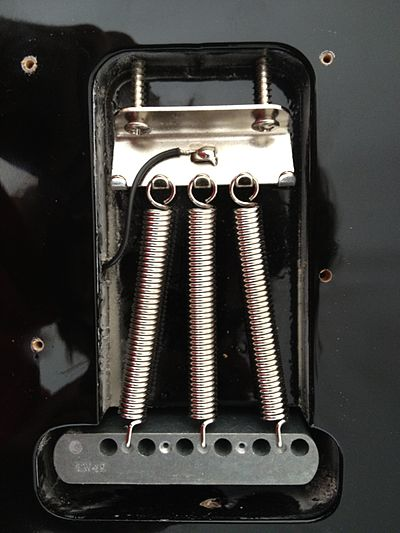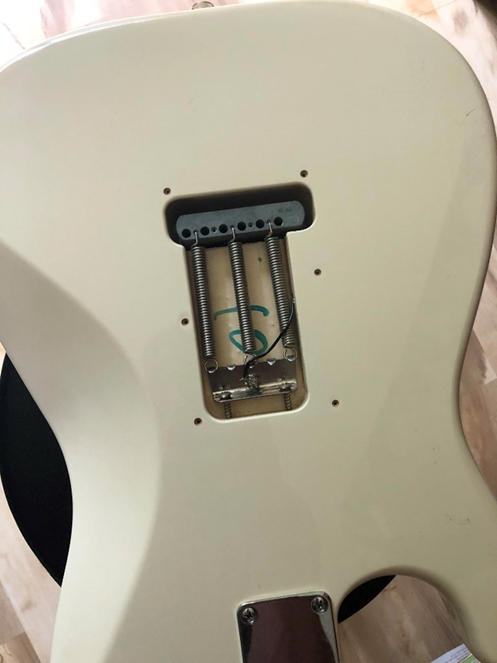A Fender Stratocaster has so much adjustment capability that it can easily get cattywumpus. Luckily, adjusting it isn’t rocket science but there is a bit of artistic application to get it the way you want it. It also requires a “adjust one thing, check and adjust something else” approach.
Floating Adjustment
This focuses on setting the whammy (bridge) so you can use the vibrato both down and up. If you want to use a hardtail or block off the bridge then that is a different article.
Fender Spec: 1/8″ off the body at the back of the whammy
My experience is that there is a lot of personal preference variations on how to setup a whammy so I go though a few different options.
Bending Down Only
Some players only go DOWN on the whammy and don’t bend up. If you do this then the whammy would be flush to the surface. Normally you wouldn’t use all the springs (all 5). I never set them up THAT way myself; and too many springs make it hard to use and take away my ability to do vibrato with finesse.
Bending Up and Down
This is the normal setup. You can set it to bend up only a certain amount but it varies with which string you using and if it is a full step, half step or more. This set to your playing style OR the default fender recommended height. This allows you to do vibrato on a string and not just down movement. The preferred method.
Spring Setup
I always set up 3 springs. Fender does as well. But I like to use the 3 outside holes on the bridge and the 3 inside holes on the Claw. This has an interesting effect of making the resistance different depending on the amount of bend and feels less tight to me. It looks like the center spring is straight and the other 2 are at angle and have more resistance and stretch. This is a very popular option. I find that it moves smoother I’m guessing because the outside strings are stretched more than the center so they offer more resistance to movement, but as the center one gets stretched it becomes more rigid which leads to a non linear whammy response that gets slightly harder to push as you get further from “rest” position but it does so in a nonlinear fashion.

Fender sometimes makes them all straight on the two outside holes and the inside hole. I never use this way because I like the nonlinear response.

Tell me more about springs
Spring do NOT all have the same tension. Older springs get stretched, cheaper material or blends result in a responsive that isn’t smooth. It’s best to use springs from the same batch. So this mean some springs need a longer length than others, and will bend differently.
Claw Screw Adjustment
The Claw is a major player in how easy it is to bend the strings with the whammy AND it also affects how the bridge rides above the body (floats). Since I use the angled 3 springs I usually adjust the guitar strings to location, then adjust the claw to get the desired back angle on the bridge. When you change the claw position it affects everything in your setup in some way so you WILL end up going back and forth. ONLY when I’m done do I fine tune the height of the strings with the saddles.
Generally speaking when you use higher gauge strings you will end up screwing in the screws MORE than if you use a lighter gauge set, for the same “float”. The bar will be stiffer to use as well because the springs are stretched more.
String Gauge
If you change the strings GAUGE you should readjust everything to be correct because of the increased string tension it pulls more on the bridge and tends to float higher. It also pulls on the neck so it will change the neck bow a little. So assume if you are changing the gauge of strings you use, you must address every aspect of your Stratocaster, not just the saddles and neck.
Side Effects of changing the bridge angle
As you change the angle of the FLOAT then it has the affect of lowering and raising the string height . This means that any adjustment of the claw, may affect where you want the saddles adjusted (height of the saddles) which in turn COULD affect the neck settings (but the difference isn’t huge so you’d probably be ok most of the time). I usually adjust the overall setup first then fine tune the feel of the whammy, then readjust everything as needed. This happens more than one time so there is often an “adjust this, tweek that” mentality when setting things up. If you have new strings, this could make you want to adjust it yet again after playing for a while (but not a lot).
Down Vibrato yet again
Most players only use the whammy for down movements and occasionally for a vibrato. Usually a vibrato doesn’t require a large upward movement so a small float will do the trick if this is what you focus on.
HIGH ANGLES
I have and sometimes like a higher angle then the spec calls for by Fender. This can be really fun and allow lots of vibrato movement. I usually like an “easy” to manipulate vibrato in these cases. Not everyone likes the “feather” touch and if you strum hard this is likely not the setup for you (or if you use heavy gauge string). It also affects the action a lot.
4 or 5 springs
I never do this but it can and is sometimes done. Normally it’s done when a player doesn’t want to use the vibrato. Sometimes it’s done when someone has a heavily playing style or/and uses heavy strings. 5 springs basically LOCK the vibrato in place and if the claw were adjusted enough the whammy would be incredibly stiff. I vote no on this one but it’s dealers choice.
2 Springs
I rarely use 2 springs because usually the bridge gets to loose but if the springs are tighter this can and does work. The tuning gets affected and the whammy and the whammy may not stay stable if the springs are not crisp in their response. But if you use 8’s as your top string with a super light bottom you “could” use 2 springs but you would end up with the claw screwed in tighter. Not a normal setup but it could work with ultra light strings or in the case of hard to stretch springs to give a lighter feel to the whammy. Sometime this may cause tuning issues over time or if the bridge pieces aren’t smooth enough this has a larger effect on tuning stability.
Whammy Length
Very very personal, I bend mine to specific bend and angle but am slightly less fussy on length as long as it isn’t really LONG. Really long whammy’s are a sign of a cheap whammy and they show up on Ebay all the time. That $5 whammy isn’t worth $5. Some famous players liked it really short (like David Gilmour) and some like the “vintage” style Whammy instead of the all metal pop in modern one. I like both but they make me play different.
When you buy a whammy bar the length and angles are not consistent unless you get a “Fender” one which has consistent specs. That does NOT mean they are made in US, it only means are more likely to have tighter specs. If you buy a “Made for Stratocaster” whammy on e-bay you get what you get so just be aware of that. Those cheapies on E-Bay aren’t always such a good buy.
GOING OUT OF TUNE
In brief, there are a LOT of things to address this problem. Here’s a condensed list of things to check for in no specific order. A properly adjusted Stratocaster is WAY more durable than some people think!
- Binding on Nut (graphite or verify nut slot is correct)
- Binding on tree (this happens if the tree is manually changed or it may be related to the nut
- Binding on the Saddle (make sure you have a smooth track over the saddle)
- Old Strings (yep, this does affect things)
- Springs not balance (at a strange angle)
- Too steep of an angle (I’ve seen this were some adjusted the saddle WAY back to the bridge causing a step break angle – and sometimes broken string)
- Different springs – always use the same springs for all 3 springs.
- Crappy strings or a bad string run (normally good string, just got a bad batch)
- Bad job at winding the string on the machine head post. (always do a locking wrap if you don’t have locking tuners)
Copyright (c) by Bruce Gombrelli Original document: 7.15.2020 – Updated may times – last update 9.20.2021
Next article: Dealing with Saddles and Nuts